 Somehow I'd only consumed one pie, hastily and in the front seat of a car, during my stay in New Zealand, a situation I was determined to remedy. So on my last day in the country Hock did a bit of online research and we headed over to Kingsland to sample what the Internet told us were Auckland's best pies.
Somehow I'd only consumed one pie, hastily and in the front seat of a car, during my stay in New Zealand, a situation I was determined to remedy. So on my last day in the country Hock did a bit of online research and we headed over to Kingsland to sample what the Internet told us were Auckland's best pies.
Arriving at The Fridge I followed Hock's strict instructions and avoided the Thai Red Curry Chicken and Moroccan Lamb pies and instead grabbed a Mince, a Steak and Guinness and something having to do with cheese and potato. The pies were $6, which apparently makes them somewhat spendy by Auckland pie standards.
We stopped at One Tree Hill Park and dug in:

The mince was a classic, with a buttery flaky crust and a rich filling that, coupled with liberal squirts of tomato sauce, made a huge mess. The Steak and Guinness boasted a decent but somewhat bland stew-like filling with carrots and potatoes. And the cheese and potato pie was predominately gloopy and heavy.
I'm not qualified to say whether or not these are Auckland's best pies, but I thoroughly enjoyed the mince in particular, and Hock, a native and pie enthusiast, seemed to agree. And if I'm being totally honest, I even enjoyed the half of the cheese and potato pie, as it ensured that I had absolutely no reason to eat airline food -- even if I wouldn't eat for another four hours.
The Fridge 507 New North Road Kingsland, Auckland New Zealand +64 (0)9 845 5321 730am-4pm Mon-Fri, 8am-4pm Sat & Sun
View Thai Eats in a larger map












 Because I've lived nearly my entire adult life in Thailand, a place where eating things such as
Because I've lived nearly my entire adult life in Thailand, a place where eating things such as 








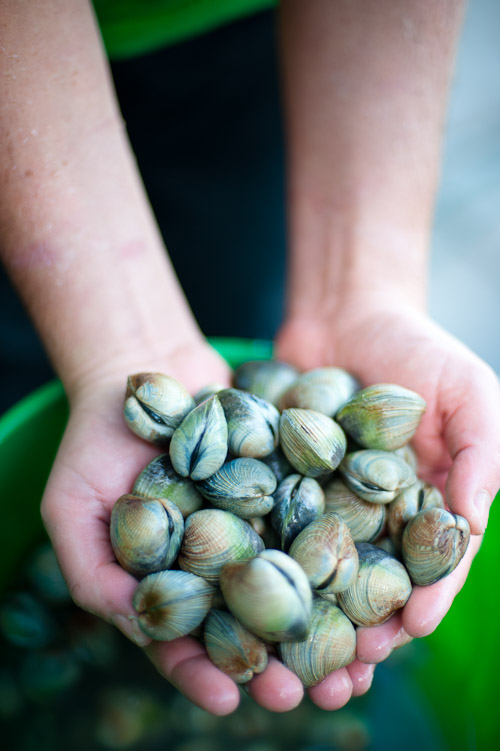 Frankly, I wasn't blown away by my restaurant meals during my recent stay in Auckland. We had some genuinely fun and tasty dinners, but what I'll continue to remember are the meals based around ingredients that we were able to pick, scavenge and hunt ourselves.
Frankly, I wasn't blown away by my restaurant meals during my recent stay in Auckland. We had some genuinely fun and tasty dinners, but what I'll continue to remember are the meals based around ingredients that we were able to pick, scavenge and hunt ourselves.
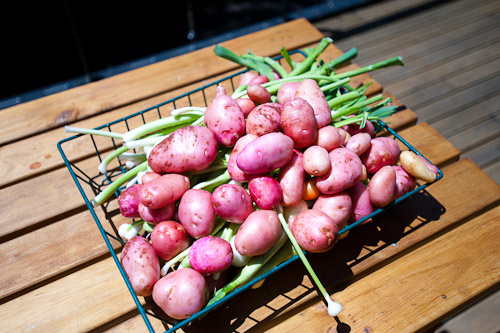


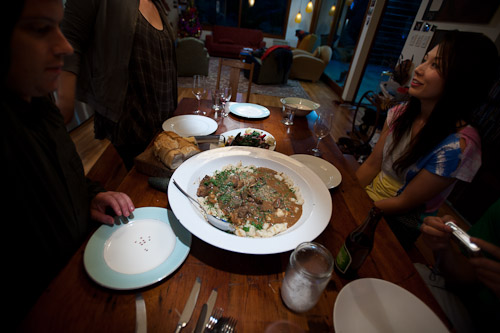

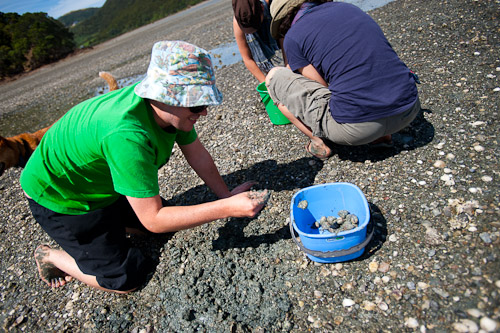
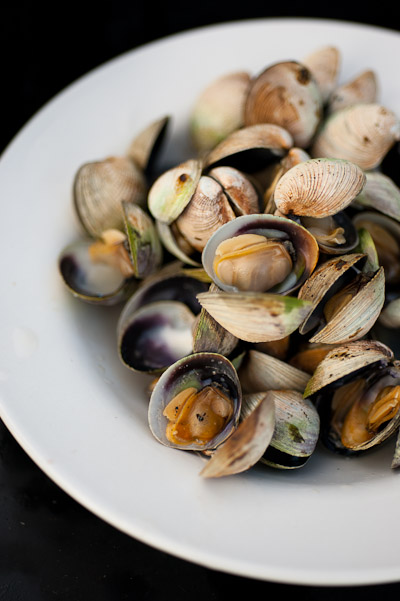


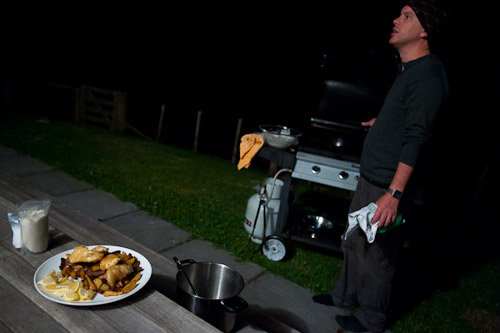
 Khao khluk kapi at Ratana, a curry stall in Bangkok's Nang Loeng Market
Khao khluk kapi at Ratana, a curry stall in Bangkok's Nang Loeng Market  In my previous post I mentioned that I was on a hunt for obscure ethnic restaurants in Bangkok. Well, after a bit of research, I think it's safe to say that it doesn't get much more obscure than my most recent discovery. Amirra is a minuscule, family-run restaurant that serves the food of the African nation of Cameroon.
In my previous post I mentioned that I was on a hunt for obscure ethnic restaurants in Bangkok. Well, after a bit of research, I think it's safe to say that it doesn't get much more obscure than my most recent discovery. Amirra is a minuscule, family-run restaurant that serves the food of the African nation of Cameroon.

 I'm currently at work on a piece about obscure ethnic restaurants for
I'm currently at work on a piece about obscure ethnic restaurants for 
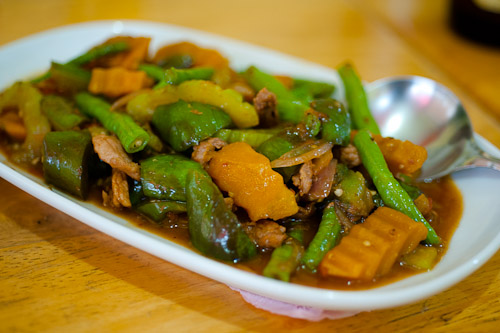


 When I find myself in an unfamiliar province somewhere in Thailand and am in need of something to eat, my first course of action is typically to call Suthon Sukphisit. Khun Suthon writes the Cornucopia column that runs every Sunday in the Bangkok Post and is a wealth of knowledge about regional Thai food and interesting restaurants. In fact, I think Khun Suthon has been so many restaurants around Thailand that he's beginning to get them mixed up. On a recent trip to Suphanburi, a province about two hours north of Bangkok, I called Khun Suthon to ask if he had any recommendations and without hesitation he replied, "You should go to Paa Muay, it's in Pang Plaa Maa District, just outside Suphanburi." I made a mental note and headed off to Bang Plaa Maa, only to find that there was no Paa Muay, but rather the almost identically-named restaurants Phii Muay, Paa Muay (different tone) and Mae Buay. Not wanting to bother Khun Suthon any more, we placed our bets on Mae Buay, grandest of the lot. And although I haven't yet confirmed it with Khun Suthon, I'm pretty sure we made the right choice.
When I find myself in an unfamiliar province somewhere in Thailand and am in need of something to eat, my first course of action is typically to call Suthon Sukphisit. Khun Suthon writes the Cornucopia column that runs every Sunday in the Bangkok Post and is a wealth of knowledge about regional Thai food and interesting restaurants. In fact, I think Khun Suthon has been so many restaurants around Thailand that he's beginning to get them mixed up. On a recent trip to Suphanburi, a province about two hours north of Bangkok, I called Khun Suthon to ask if he had any recommendations and without hesitation he replied, "You should go to Paa Muay, it's in Pang Plaa Maa District, just outside Suphanburi." I made a mental note and headed off to Bang Plaa Maa, only to find that there was no Paa Muay, but rather the almost identically-named restaurants Phii Muay, Paa Muay (different tone) and Mae Buay. Not wanting to bother Khun Suthon any more, we placed our bets on Mae Buay, grandest of the lot. And although I haven't yet confirmed it with Khun Suthon, I'm pretty sure we made the right choice.


 I was originally drawn to Café Ou Mun, a tiny café in central Macau, for little more than an early morning galão (the Portuguese equivalent of a café au lait) and a pastry. But the quality of the food led me to make a few more visits, including one proper meal.
I was originally drawn to Café Ou Mun, a tiny café in central Macau, for little more than an early morning galão (the Portuguese equivalent of a café au lait) and a pastry. But the quality of the food led me to make a few more visits, including one proper meal.




 Despite my
Despite my 

 Those wishing to taste the true flavours of old Macau can do no better than stop by Riquexó, a restaurant serving Macanese cuisine, a blend of Portuguese, Chinese, and on occasion, Southeast Asian ingredients and cooking styles.
Those wishing to taste the true flavours of old Macau can do no better than stop by Riquexó, a restaurant serving Macanese cuisine, a blend of Portuguese, Chinese, and on occasion, Southeast Asian ingredients and cooking styles.



 Art critic and mate Steven Pettifor has put together
Art critic and mate Steven Pettifor has put together  Despite having owned the place for five centuries, the Portuguese influence on Macau is actually quite superficial. The Macau of today is essentially a very Chinese city with a few Portuguese-style buildings, a very small minority of people of Portuguese descent, a handful of Portuguese restaurants and an abundance of azulejos (Portuguese blue tiles). Fortunately Macau is rather compact, so for those interested, seeking out the remnants of Portuguese culture, particularly those that are edible, is not difficult. And perhaps the most ubiquitous and tastiest remnant of the Portuguese colonial legacy are pastéis de nata, or more commonly in Macau, Portuguese egg tarts.
Despite having owned the place for five centuries, the Portuguese influence on Macau is actually quite superficial. The Macau of today is essentially a very Chinese city with a few Portuguese-style buildings, a very small minority of people of Portuguese descent, a handful of Portuguese restaurants and an abundance of azulejos (Portuguese blue tiles). Fortunately Macau is rather compact, so for those interested, seeking out the remnants of Portuguese culture, particularly those that are edible, is not difficult. And perhaps the most ubiquitous and tastiest remnant of the Portuguese colonial legacy are pastéis de nata, or more commonly in Macau, Portuguese egg tarts.
 I've always liked the idea of dim sum -- countless small Chinese dishes served with an endless flow of green tea (one of my favourite things to drink) sounds wonderful to me -- but I'd yet to encounter a version that I truly enjoyed. My first authentic dim sum meals in Macau and Malaysia were fun, but too meaty and oily for my taste, while much of the dim sum I've come across in Thailand has been processed and flavourless (in addition to being meaty and oily). I thought for sure that I would finally meet my fantasy dim sum in Hong Kong, a city virtually synonymous with the dish, and to a certain extent, I did. In Lin Heung Tea House I found a restaurant that fit my preconceived notion of how a dim sum place should be: a great old hall complete with grumpy waiters, creaking trolleys, old men reading newspapers, lazy ceiling fans and lots of cigarette smoke and tea. But as with previous attempts, I was let down by the food.
I've always liked the idea of dim sum -- countless small Chinese dishes served with an endless flow of green tea (one of my favourite things to drink) sounds wonderful to me -- but I'd yet to encounter a version that I truly enjoyed. My first authentic dim sum meals in Macau and Malaysia were fun, but too meaty and oily for my taste, while much of the dim sum I've come across in Thailand has been processed and flavourless (in addition to being meaty and oily). I thought for sure that I would finally meet my fantasy dim sum in Hong Kong, a city virtually synonymous with the dish, and to a certain extent, I did. In Lin Heung Tea House I found a restaurant that fit my preconceived notion of how a dim sum place should be: a great old hall complete with grumpy waiters, creaking trolleys, old men reading newspapers, lazy ceiling fans and lots of cigarette smoke and tea. But as with previous attempts, I was let down by the food.
 In 2008 the Michelin guide expanded its borders to include Hong Kong and Macau. This gained quite a bit of attention in the international media, as the influential guide had previously limited itself to fine dining in Western countries. This apparently also generated a great deal of interest in Hong Kong, as in an effort to promote the accomplishment, I was taken to two Michelin-starred restaurants on my recent press trip there. Of these, the restaurant that stands out the most in my mind is Yung Kee, a nearly 60 year-old Hong Kong staple and recent recipient of a single Michelin star.
In 2008 the Michelin guide expanded its borders to include Hong Kong and Macau. This gained quite a bit of attention in the international media, as the influential guide had previously limited itself to fine dining in Western countries. This apparently also generated a great deal of interest in Hong Kong, as in an effort to promote the accomplishment, I was taken to two Michelin-starred restaurants on my recent press trip there. Of these, the restaurant that stands out the most in my mind is Yung Kee, a nearly 60 year-old Hong Kong staple and recent recipient of a single Michelin star.




 While in Hong Kong I got the chance to eat at some Michelin-starred restaurants (one of which I'll blog on soon) and a few other similarly upscale places, but to be honest, what I really wanted to do was eat what regular Hong Kong people eat. I finally got my chance at Nathan Congee and Noodle, a closet-sized restaurant in Kowloon.
While in Hong Kong I got the chance to eat at some Michelin-starred restaurants (one of which I'll blog on soon) and a few other similarly upscale places, but to be honest, what I really wanted to do was eat what regular Hong Kong people eat. I finally got my chance at Nathan Congee and Noodle, a closet-sized restaurant in Kowloon.




 Chefs at work in the kitchen of the InterContinental Hong Kong's Chinese restaurant
Chefs at work in the kitchen of the InterContinental Hong Kong's Chinese restaurant I'm a bit late on relaying this, but Thailand's annual Jay or vegetarian festival is currently is full swing. I've made a couple trips to Bangkok's Chinatown, the centre of activity, and I can report with confidence that the offerings are as vegetable-free and oily as ever:
I'm a bit late on relaying this, but Thailand's annual Jay or vegetarian festival is currently is full swing. I've made a couple trips to Bangkok's Chinatown, the centre of activity, and I can report with confidence that the offerings are as vegetable-free and oily as ever: